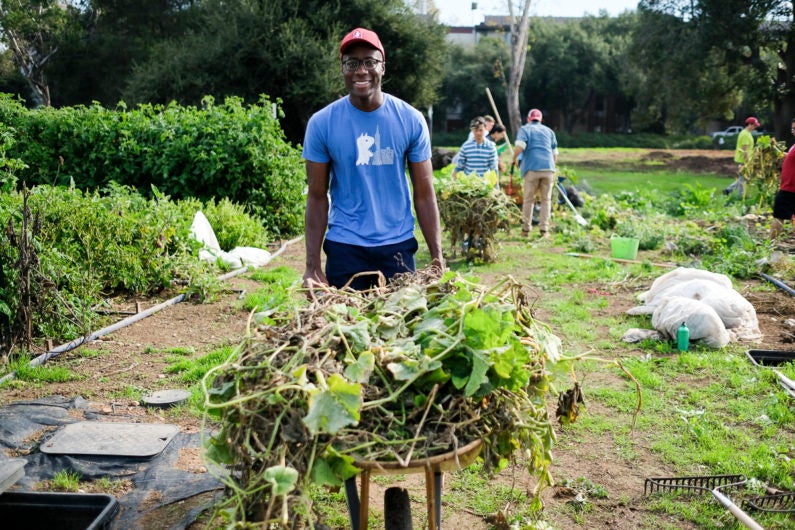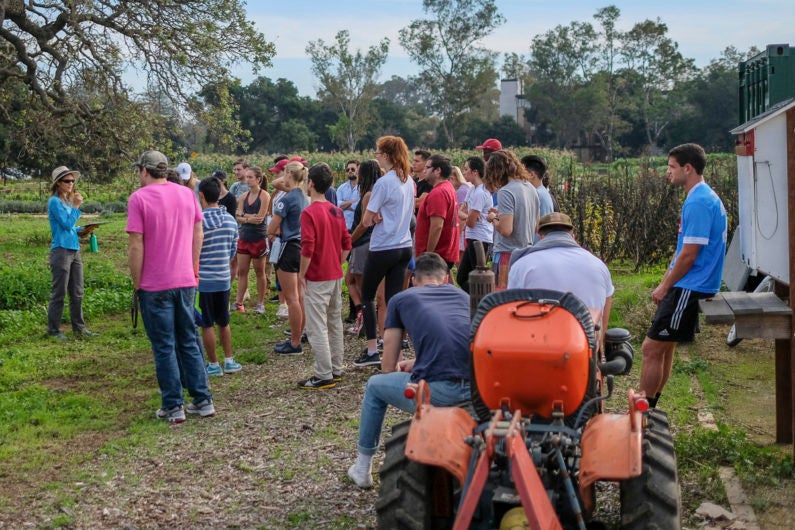Stanford Educational Farm hosts class sessions from across campus
Stanford Earth aims to draw more than 1,000 students from multiple majors for field learning every year at its working farm, complete with animals and crops.
On a 6-acre spread on the west side of campus, scents of lavender and mint lead the way into the O’Donohue Family Stanford Educational Farm.
Go to the web site to view the video.
Tucked away at the corner of Campus Drive and Electioneer Road near the university’s historic Red Barn, the farm houses a mini-ecosystem that includes chickens, bees, flowers and a cornucopia of edible crops. Programming at the farm, which is operated by the School of Earth, Energy & Environmental Sciences, started in earnest in 2015. Now, many Stanford students do not have to seek out the living laboratory – their classes are bringing them to it.
All together, more than 450 students have visited the farm for a class module, field trip, student club activity or other use since fall 2016. By the end of the next academic year, farm director and lecturer Patrick Archie aspires to have more than 1,000 students visiting annually for a learning purpose.
“You really see students on the farm making connections that are integrating and synthesizing information in a way that’s facilitated by being together in this space and interacting with the world, as opposed to only being in the classroom – it’s absolutely a fantastic complement to the classroom,” Archie said.
Academic field trips
In September, Stanford Earth launched an initiative to expose students to the farm by incorporating it into curricula all around campus. Through its new Academic Field Trip Program, instructors across the university are creating class sessions on the farm tailored to their teaching goals. For example, in a Program in Writing and Rhetoric class taught by Stanford lecturer Lauren Oakes, students explored aspects of agricultural production to learn how to contrast different perspectives on sustainability for a writing assignment.

Senior Paa Adu, an electrical engineering major, collects weeds and takes them to the compost pile during an Earth Systems 10 class field trip to the O’Donohue Family Stanford Educational Farm. (Image credit: Ker Than)
“This is an opportunity for students to direct their own learning to some extent and discover new things that don’t just come from an instructor, but also from their engagement with the piece of land,” said Stanford Earth instructor Liz Carlisle, who runs the Academic Field Trip Program with support from Archie. “We’ve really prioritized first-year students who will have a chance to continue engaging with the farm throughout their time here.”
Drawing on her experience as a writer, educator and advocate for sustainable agriculture, Carlisle works with faculty from the arts, humanities, social sciences and natural sciences to integrate their course objectives. The field trips incorporate sustainability, often highlighting some of the focus areas at Stanford Earth: food, water, energy and climate security. The program exposes students to the farm who otherwise may not visit and feedback has been overwhelmingly positive, Carlisle said.
“If it’s designed well, where the classroom learning goals align with what the farm can offer, visiting the farm can make concepts that seem quite abstract come alive and become much more tangible to a student grappling with them,” said Oakes, who has participated in the program twice since its inception and is offering another course in the spring.
While touring the farm, Oakes’ students identified flowers, edible weeds and crops grown among other plant species as evidence for assessing arguments about the environment from different points of view.
“The goal was to get students to dive deeply into one issue of sustainability and compare and contrast different perspectives on it,” Oakes said. “They did it through a corporate lens in one exercise that week in class, and then in a completely different world, in an agricultural setting at the farm.”
Cross-campus draw
Programs and departments with participating courses to date have included Science, Technology and Society; the Program in Writing and Rhetoric; Thinking Matters; Education; French; Mechanical Engineering; and Art. During fall quarter alone, the farm hosted 17 field trips that reached about 250 students, and Carlisle and Archie expect to see a similar turnout during spring’s warmer weather.

Instructor Liz Carlisle, left, teaches an Earth Systems 10 class during a field trip to the farm. (Image credit: Ker Than)
Freshman Maggie McGraw participated in a field trip through Earth Systems 10: Introduction to Earth Systems. She learned how drip irrigation improves the taste of tomatoes, that Stanford dining halls use produce from the farm, and how diet, food production and a sustainable environment are all interconnected.
“It’s definitely something everyone at Stanford should go look at and at least volunteer once because it gives you an eye into what the environmental science side of Stanford is really about,” said McGraw, who is now recruiting friends to volunteer at the farm. “I just want to go back.”
In addition to incorporating specific learning goals, most academic field trips include a tour of the farm and an opportunity to taste some of its harvest. During the field trip for Earth Systems 10 – the Earth Systems course that introduces students to a wide variety of interactions that characterize global change problems – students got their hands dirty weeding and mulching until the sun began to set.
Once it became dark and cold outside, Carlisle announced it was time to eat strawberries: “That’s actually really powerful, too – just to have that sensory experience and to pick something and to eat it.”
Aiming for 80×20
The Academic Field Trip Program supports Stanford Earth’s mission to reach 80 percent of Stanford’s undergraduate student body by 2020. By visiting the farm, students are learning about concepts integral to understanding sustainability, including symbiosis, nutrient cycling and the relationships between food production, ecology, economics and health.
“What you’ve learned in class can be done on a realistic scale,” said freshman Jonathan Gilbert, who visited the farm with a Thinking Matters class, Sustainability Challenges and Transitions, co-taught by Stanford Earth Dean Pamela Matson, an environmental scientist. “You can make something theoretical very real, even if you don’t have a huge amount of space.”
Gilbert said the field trip helped him make physical connections with what he had been reading about in class. He described the space as a “breeding ground of botanical experimentation” and expressed interest in returning to learn more about farming techniques.
“I honestly think that the farm was one of the highlights of the class – just being able to get out and explore it,” Gilbert said. “The tour was put together really well and I enjoyed the class.”
In addition to its sustainability-themed learning, the farm has hosted groups interested in documenting the space, such as drawing and writing classes. Archie said he hopes to expand the Academic Field Trip Program to a diversity of fields. “What’s interesting and exciting for Liz and me is to be able to teach using this facility to engage people from different disciplines,” Archie said.
A farm on the Farm
Stanford has been informally known as “the Farm” since the university was established by Leland and Jane Stanford on their Palo Alto stock farm. Its founding grant included maintenance of “a farm for instruction in agriculture” on university lands. Additionally, the farm fulfills Stanford’s commitment to addressing critical sustainability challenges of the 21st century.
“We really want this to be a farm for all Stanford students,” Carlisle said. “The farm is here to give students an opportunity to be land stewards and to think about what that means for society.”
For more information about the O’Donohue Family Stanford Educational Farm, including volunteer opportunities and applications to participate in the Academic Field Trip Program, visit earth.stanford.edu/farm.
